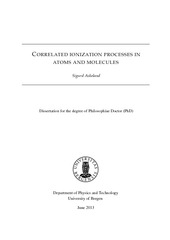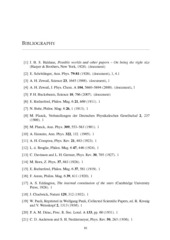| dc.contributor.author | Askeland, Sigurd | eng |
| dc.date.accessioned | 2013-10-09T13:49:24Z | |
| dc.date.available | 2013-10-09T13:49:24Z | |
| dc.date.issued | 2013-09-27 | eng |
| dc.identifier.isbn | 978-82-308-2376-7 | en_US |
| dc.identifier.uri | https://hdl.handle.net/1956/7378 | |
| dc.description.abstract | This thesis is composed of five scientific papers written between 2009 and 2013. The focus of this work is on various photo-ionization processes in small atoms and molecules. The strong field phenomenon called “atomic stabilization” is studied both in hydrogen and helium. Special attention is paid to the electronic interaction effects in helium. Using weaker laser fields, the correlation-dependent process called two-photon double ionization (TPDI) is studied in detail. The hydrogen molecular ion, H+2 , is studied in the Born-Oppenheimer approximation. The nuclear dynamics in two-photon processes are investigated in pump-probe simulations. The first chapter of the thesis is an introduction to quantum mechanics and to our work. A brief historical overview of the field is presented, as well as a short description of the physics that is presented in the thesis. The second chapter contains a thorough introduction to atomic stabilization, with focus on the physical processes in play. Atomic stabilization is the term used for reduced likelihood of ionization with increased laser intensity. This is a counter-intuitive result, which is caused by the reduced nucleus-electron interaction for large electron displacements in strong fields. In the third chapter, correlation effects in helium are described. More specifically, one describes the two-photon double ionization process, and explain how to extract and analyze the correlation-related information from the propagated helium wavefunction. Chapter four introduces the system studied in Paper V, the H+2 molecule. Tools for solving the H+2 Schrödinger equation are presented, such as the Born-Oppenheimer approximation and the prolate spheroidal coordinate system. The processes studied in Paper V are explained in detail. In Paper I, ab initio calculations of the helium atom in the stabilization regime is reported. Stabilization is observed for several different laser frequencies and pulse durations. Due to the electron correlation, the effect is smaller than in hydrogen, or in an independent electron model of helium. Using the Kramers-Henneberger frame of reference, we explain why the electronic interaction is important in the limit of very strong fields. In Paper II, stabilization is explored for circular Rydberg states in hydrogen, and circularly polarized lasers. Since the torus shaped initial wavefunction is far from the nucleus, the ionization probability is low until the electron displacement is on the order of the torus radius. This illustrates the importance of the nucleus’ proximity to the wavefunction for ionization to happen. Differences in ionization probability for counter-rotating and co-rotating electric fields is pointed out, and an explanation, based on classical trajectory Monte Carlo simulations, is presented. Paper III focus on two-photon double ionization of helium. The angular distribution of the emitted electrons shows a significant change when the photon energy gets close to the lower TPDI threshold. We attribute this effect to a different dominant ionization mechanism for low energy photons, namely a “knock-out” effect, rather than a “shakeoff” effect. The relative likelihood of TPDI and two-photon single ionization across the TPDI range strengthens this hypothesis. In Paper IV, we report the effect propagation after the pulse has on the different cross sections for a TPDI scenario in helium. Aside from the expected increase in the cross section with post-propagation, we find that the shape of the single- and tripledifferential cross sections do not change much after the pulse is over. Some slight perturbations are observed in the triple-differential cross section in the θ1 = 90◦ case. They are consistent with electron-electron repulsion after the pulse. Leaving the atomic systems behind, Paper V studies the H+2 system in the Born- Oppenheimer approximation. The coupling to the 3pσu states are investigated by a resonant pump pulse. The wavepacket is ionized by a probe pulse, and characteristic nuclear energy spectra can be extracted from the continuum. The structures in the kinetic energy release spectra are interpreted as a result of the node on the 1sσg-3pσu dipole coupling. We successfully used chirped laser pulses to emphasize the signal from 3pσu, while suppressing contributions from other ionization channels. | en_US |
| dc.language.iso | eng | eng |
| dc.publisher | The University of Bergen | en_US |
| dc.relation.haspart | Paper I: S. A. Sørngård, S. Askeland, R. Nepstad, and M. Førre, Multiphoton ionization and stabilization of helium in superintense xuv fields, Physical Review A 83, 033414 (2011). The article is available here: <a href="http://hdl.handle.net/1956/7379" target="blank">http://hdl.handle.net/1956/7379</a> | en_US |
| dc.relation.haspart | Paper II: S. Askeland, S. A. Sørngård, I. Pilskog, R. Nepstad and M. Førre, Stabilization of circular Rydberg atoms by circularly polarized infrared laser fields, Physical Review A 84, 033423, (2011). The article is available here: <a href="http://hdl.handle.net/1956/7412" target="blank"> http://hdl.handle.net/1956/7412</a> | en_US |
| dc.relation.haspart | Paper III: S. Askeland, R. Nepstad and M. Førre, Two-photon double ionization of helium by attosecond laser pulses: Evidence of highly correlated electron motion, Physical Review A 85, 035404, (2012). The article is available here: <a href="http://hdl.handle.net/1956/7413" target="blank"> http://hdl.handle.net/1956/7413</a> | en_US |
| dc.relation.haspart | Paper IV: A. S. Simonsen, S. Askeland and M. Førre, Two-photon double ionization of helium: investigating the importance of correlation in the final state, Central European Journal of Physics, (2013). Full-text not available in BORA. The published version is available at: <a href="http://dx.doi.org/10.2478/s11534-013-0180-x" target="blank"> http://dx.doi.org/10.2478/s11534-013-0180-x</a> | en_US |
| dc.relation.haspart | Paper V: S. Askeland and M. Førre, Probing two-center interference in H+2 using chirped pulses, submitted to Physical Review A. The article is available here: <a href="http://hdl.handle.net/1956/7414" target="blank">http://hdl.handle.net/1956/7414</a> | en_US |
| dc.title | Correlated ionization processes in atoms and molecules | en_US |
| dc.type | Doctoral thesis | |
| dc.rights.holder | Copyright the author. All rights reserved | en_US |

